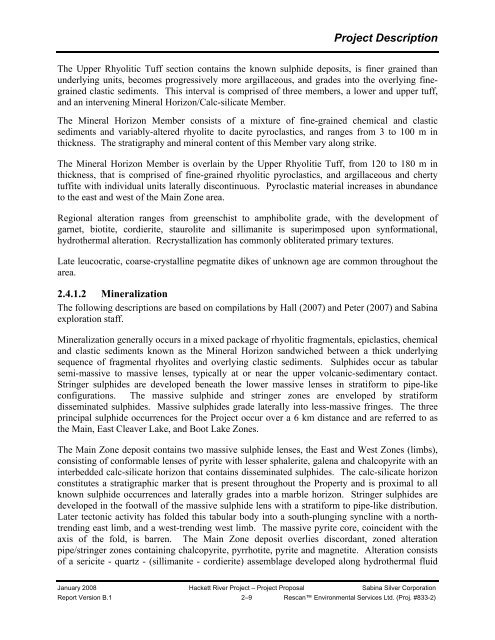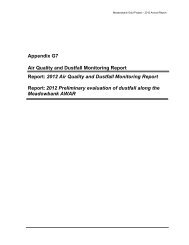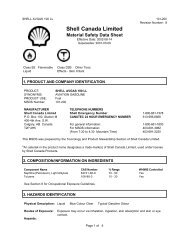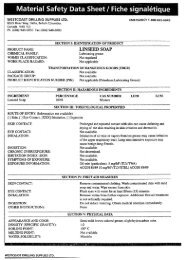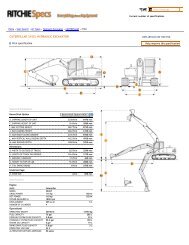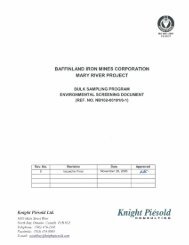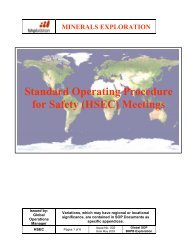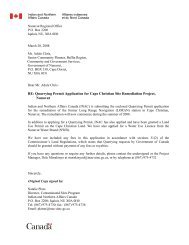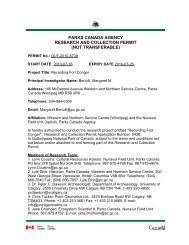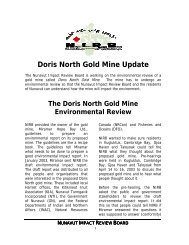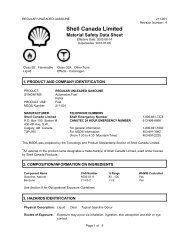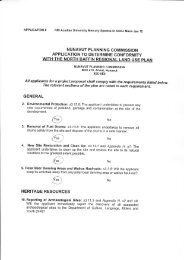080121-08MN006-Sabina Hackett River Project Proposal ... - NIRB
080121-08MN006-Sabina Hackett River Project Proposal ... - NIRB
080121-08MN006-Sabina Hackett River Project Proposal ... - NIRB
You also want an ePaper? Increase the reach of your titles
YUMPU automatically turns print PDFs into web optimized ePapers that Google loves.
<strong>Project</strong> DescriptionThe Upper Rhyolitic Tuff section contains the known sulphide deposits, is finer grained thanunderlying units, becomes progressively more argillaceous, and grades into the overlying finegrainedclastic sediments. This interval is comprised of three members, a lower and upper tuff,and an intervening Mineral Horizon/Calc-silicate Member.The Mineral Horizon Member consists of a mixture of fine-grained chemical and clasticsediments and variably-altered rhyolite to dacite pyroclastics, and ranges from 3 to 100 m inthickness. The stratigraphy and mineral content of this Member vary along strike.The Mineral Horizon Member is overlain by the Upper Rhyolitie Tuff, from 120 to 180 m inthickness, that is comprised of fine-grained rhyolitic pyroclastics, and argillaceous and chertytuffite with individual units laterally discontinuous. Pyroclastic material increases in abundanceto the east and west of the Main Zone area.Regional alteration ranges from greenschist to amphibolite grade, with the development ofgarnet, biotite, cordierite, staurolite and sillimanite is superimposed upon synformational,hydrothermal alteration. Recrystallization has commonly obliterated primary textures.Late leucocratic, coarse-crystalline pegmatite dikes of unknown age are common throughout thearea.2.4.1.2 MineralizationThe following descriptions are based on compilations by Hall (2007) and Peter (2007) and <strong>Sabina</strong>exploration staff.Mineralization generally occurs in a mixed package of rhyolitic fragmentals, epiclastics, chemicaland clastic sediments known as the Mineral Horizon sandwiched between a thick underlyingsequence of fragmental rhyolites and overlying clastic sediments. Sulphides occur as tabularsemi-massive to massive lenses, typically at or near the upper volcanic-sedimentary contact.Stringer sulphides are developed beneath the lower massive lenses in stratiform to pipe-likeconfigurations. The massive sulphide and stringer zones are enveloped by stratiformdisseminated sulphides. Massive sulphides grade laterally into less-massive fringes. The threeprincipal sulphide occurrences for the <strong>Project</strong> occur over a 6 km distance and are referred to asthe Main, East Cleaver Lake, and Boot Lake Zones.The Main Zone deposit contains two massive sulphide lenses, the East and West Zones (limbs),consisting of conformable lenses of pyrite with lesser sphalerite, galena and chalcopyrite with aninterbedded calc-silicate horizon that contains disseminated sulphides. The calc-silicate horizonconstitutes a stratigraphic marker that is present throughout the Property and is proximal to allknown sulphide occurrences and laterally grades into a marble horizon. Stringer sulphides aredeveloped in the footwall of the massive sulphide lens with a stratiform to pipe-like distribution.Later tectonic activity has folded this tabular body into a south-plunging syncline with a northtrendingeast limb, and a west-trending west limb. The massive pyrite core, coincident with theaxis of the fold, is barren. The Main Zone deposit overlies discordant, zoned alterationpipe/stringer zones containing chalcopyrite, pyrrhotite, pyrite and magnetite. Alteration consistsof a sericite - quartz - (sillimanite - cordierite) assemblage developed along hydrothermal fluidJanuary 2008 <strong>Hackett</strong> <strong>River</strong> <strong>Project</strong> – <strong>Project</strong> <strong>Proposal</strong> <strong>Sabina</strong> Silver CorporationReport Version B.1 2–9 Rescan Environmental Services Ltd. (Proj. #833-2)


